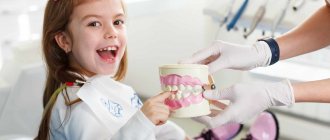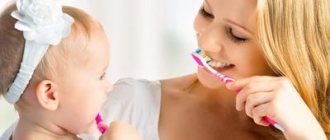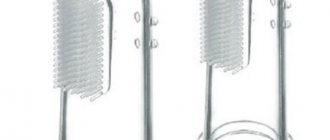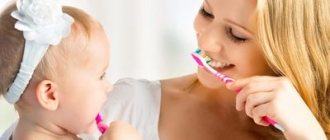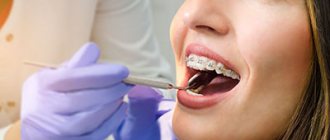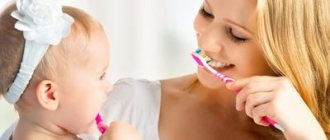Treatment of dental pathologies in children is a complex process that requires extensive practical experience and knowledge of child psychology. Especially when it comes to baby teeth. In order not to damage the rudiments of permanent units, the doctor must perfectly know the technique of performing manipulations and act very carefully.
Children's doctors at the Levoberezhnaya Dental Clinic try to save teeth even with extensive damage and remove them only as a last resort. You can make an appointment by calling the phone number listed on the website or using the online form.
Modern methods of treating primary teeth in children aged 2 to 4 years
Modern parents believe that treating a child’s teeth is a waste of time, because over time, milk teeth will be replaced by permanent, healthy teeth without caries.
But every pediatric dentist will call this opinion erroneous, since caries negatively affects not only the oral cavity, but also the condition of other organs and systems of the small patient. The reasons for the development of childhood caries are different. How do young children have their teeth treated today in the Russian Federation? This is done using a gentle method and using only the latest developments in dentistry. Therefore, during this procedure the baby does not experience any discomfort, much less fear.
From 2 to 4 years of age, pediatric dentistry uses the method of silvering baby teeth. A specially developed medicine is applied to the already damaged enamel. The drugs of choice are Saforide and Argenate - they contain 30% silver. After application, the dentin canals close and the spread of bacteria that cause caries stops. This procedure does not bother the baby at all, and he calmly sits for the required time in the chair.
The fluoridation procedure helps eliminate caries in children as reliably as the first method. There are two ways to go here. The first is the application of a fluoride-containing preparation with a brush to the tooth enamel. The second is treatment with a tampon, which is soaked in a special liquid. It contains copper and calcium hydroxide.
Dental treatment today is neither painful nor scary, and this is the main difference between dental offices and those that existed 20 or even 30 years ago. We use modern, effective anesthetics with different flavors, silent drills, and multi-colored fillings, the color of which the child can choose himself.
Experts' opinion
The complex composition of ASEPTA Baby toothpaste allows you to simultaneously care for your gums and teeth. The product has:
- Certificate of state registration;
- Certificate of conformity No. ROSS RU. AG81.H01070.
The paste does not contain fluoride and does not require consultation with a doctor before use. The product is safe if swallowed, as it does not contain components harmful to the health of the baby.
Sources:
- Report on determining/confirming the preventive properties of toothpaste “ASEPTA PLUS” GENTLE WHITENING” Author: doctor-researcher A.A. Leontyev, head Department of Preventive Dentistry, Doctor of Medical Sciences, Professor S.B. Ulitovsky First St. Petersburg State Medical University named after. acad. I.P. Pavlova, Department of Preventive Dentistry
- Report on the determination/confirmation of the preventive properties of personal oral hygiene products “ASEPTA PLUS” Remineralization doctor-researcher A.A. Leontyev, head Department of Preventive Dentistry, Doctor of Medical Sciences, Professor S.B. Ulitovsky First St. Petersburg State Medical University named after. acad. I.P. Pavlova, Department of Preventive Dentistry
- Clinical experience in using the Asepta series of products Fuchs Elena Ivanovna Assistant of the Department of Therapeutic and Pediatric Dentistry State Budgetary Educational Institution of Higher Professional Education Ryazan State Medical University named after Academician I.P. Pavlova of the Ministry of Health and Social Development of the Russian Federation (GBOU VPO RyazSMU Ministry of Health and Social Development of Russia)
How caries is treated today for young children under 7 years old
According to statistics, caries is one of the most common diseases in children. It proceeds differently for each preschooler, which requires a different approach to each child. Often, only the restorative procedures described above are sufficient. But sometimes a full-fledged complex therapy with fillings and further preventive monitoring of the oral cavity is required.
Treatment of caries in children is carried out with filling material, which is based on glass ionomer cement. One of the representatives of this group is the drug Vitrebond. With its help, treatment is carried out in a short time, and small lesions under this material are restored quickly and painlessly.
How are children's teeth treated in modern dentistry? The most popular method is chemical-mechanical. A medicinal gel is applied to the infected tooth, which allows you to remove damaged dentin painlessly and without the use of drills. In this case, only dead tissue is removed, so the child does not experience any discomfort or pain. Then the tooth, cleaned of carious surfaces, is filled.
The air-kinetic method allows you to clean a carious cavity using a stream of water, air and abrasive particles that enter the mouth under pressure. This jet, directed at the affected area, “washes away” caries. However, this method is effective only at the initial stage of the disease.
But here another question arises - how is pulpitis of baby teeth treated in children? It will not be possible to do this in one visit to the dentist, since the therapy is carried out in several stages. Treatment can be conservative or surgical, but the second method is not used for baby teeth. Therefore, if conservative treatment for pulpitis does not bring results, it is better to remove the affected tooth.
How to treat the teeth of a child 3 years old or older so that he is not afraid and does not cry? Laser technology helps here. Such devices are not installed in all clinics, but in large cities they are available.
And finally, the use of ozone allows you to quickly and painlessly clean the carious cavity and destroy all microbes that cause the destruction of enamel.
Why do babies get caries?
Yes, caries in children under 3 years of age still surprises parents. "How so? After all, the baby doesn’t even know cigarettes and soda yet?” - they shrug their shoulders. In fact, there are two main groups of reasons for the appearance of caries in babies: poor lifestyle during pregnancy and insufficient oral care for the child after birth. Let's look at each group separately.
Pregnancy
The expectant mother should be especially attentive to herself. The baby's teeth begin to develop around the 12th week of pregnancy. It is important for a woman to understand that the process of feeding a child is a process that begins with conception.
For the health of the baby’s teeth, hair, nails, skin and other organs, the expectant mother should choose natural products that contain the daily requirements of essential vitamins and minerals:
- Dairy
. First of all, the expectant mother should choose cottage cheese, natural yogurt and hard cheeses. These treats contain calcium, protein, vitamins B, D, and Omega-3 polyunsaturated fats that baby’s teeth need.
- Nuts
- This is a storehouse of vitamins and nutrients necessary for the formation of teeth in a baby. Nuts contain selenium, magnesium, vitamin E, phytic acids and Omega-3 polyunsaturated fatty acids.
- Fish and seafood
. Everyone knows that fish contains the phosphorus needed by bones and teeth and beneficial vitamin D, which strengthens the nervous system of a pregnant woman and baby.
- Meat, liver
. Important cell building materials are meat and liver. These products contain the protein necessary for a growing body. The liver is rich in iron and B vitamins.
- Chicken and quail eggs
. These products contain more than 10 useful vitamins and microelements that affect the growth and abilities of the baby.
- Vegetables
. Vitamins, fiber, microelements and organic acids necessary for the development of healthy baby teeth are found in abundance in vegetables. Avocados, broccoli and carrots are especially useful for the expectant mother. These vegetables (in any form - raw or cooked) contain the most calcium, vitamins B, C and folic acid.
- Berries and fruits
– vitamin support for pregnant women and the key to the normal development of the child.
- Legumes
contain iron, folic acid and vitamin B-6, necessary for mother and baby.
- Cereals
rich in B vitamins, fiber and iron. Milk porridge will be very useful.
- Spinach.
The plant contains a lot of folic acid, calcium and vitamin A. In addition, the leaves are not at all difficult to grow at home on the balcony, and then enjoy them in the form of soups, purees and side dishes.
And, of course, the expectant mother should avoid taking antibiotics: such drugs can destroy the child’s health.
At what age can teeth be treated?
At what age do children have their teeth treated? This is a question that interests all parents of preschool children.
While the child is breastfed, such a need does not arise, especially since the first teeth begin to appear no earlier than 6 months from birth. But as soon as the child begins to eat at the common table and tries food familiar to the family, parents need to be attentive to the condition of the teeth. Problems with them begin when the body begins to lack minerals. The most dangerous period is from 5 to 14 years.
Therefore, as soon as the baby turns 1 year old, he needs to visit the dentist’s office every 6 months for preventive purposes. Caries or pulpitis of baby teeth detected at an early stage can be treated much easier and faster than advanced cases.
Reviews
The first visit to the dentist can be a daunting experience for children and their parents. In each of the clinics of the Natadent network, we have created a truly warm and comfortable environment. We welcome every feedback - you help us become better.
LEAVE FEEDBACK
Where can you get your child’s teeth treated without fear?
It is good if the child is observed by one dentist throughout the entire period from early childhood to 18 years.
Firstly, the baby will always see a familiar doctor in front of him and will not be afraid, cry or worry. And secondly, a specialist who monitors the child’s dental health from an early age knows all its features and will notice the problem at the very beginning of its development. It is important not only how teeth are treated for children 2 years of age and older, but also where it is done. All establishments in the city are divided into three large groups:
- State clinics. This option is best left for last resort. Why? There are long queues, many capricious children, nervous parents and doctors who are given a limited time for an appointment and not a minute more. At the same time, dental equipment, as a rule, remains from the last century, and no one has heard of good medicines and fillings.
- Special children's rooms in high-profile private hospitals. If you are looking for a good combination of price and quality, then this option is suitable. There is all the necessary equipment, modern medications designed specifically for baby teeth, and a specialist doctor whose competence includes only the treatment of children’s first teeth will work with a boy or girl.
- Private specialized children's dental clinics. They are intended exclusively for small patients. Here everything is done for their coziness and comfort, there are no long queues, all patients come only at the appointed time, and you can make an appointment for a convenient day for an appointment. All equipment, instruments and medications are intended exclusively for children's teeth. Well, the quality of service always remains at the highest level. The only negative is the high prices, and even a simple consultation will be paid.
Which treatment methods to choose and where exactly the baby should be treated is, of course, decided by the parents. You should not go to extremes and should choose according to your financial capabilities. After all, even in a free city clinic you can get access to competent and experienced specialists. The only thing that remains is to read the reviews and ask your friends who and how they treat the teeth of children aged 4 years. If possible, immediately contact a paid pediatric dentistry.
Treatment of pulpitis
If the infection is located near or has already reached the pulp chamber of the tooth, completely different treatment methods are used.
- Direct pulp capping. With this method of treatment, the viability of the entire pulp is preserved.
- Pulpotomy (vital amputation). The infected coronal part of the pulp is removed, its root part is preserved for further development of the tooth.
- Pulpectomy (pulpoextraction). The pulp is completely removed, after which the root canals are filled.
If a small patient is brought to the clinic in a timely manner, pulpitis can be cured in one visit.
Dentist recommendations
Your baby needs to brush his teeth 2 times a day from the moment the first tooth erupts. This must be a mandatory and strictly observed rule. In this case, teeth cleaning should be of high quality; the recommended duration of the procedure is 3 minutes.
- How to choose a toothbrush for a child?
The toothbrush should be of medium hardness; pay attention to the markings according to the child’s age.
- Which toothpaste should you choose?
From 3 years of age, it is better to use toothpaste with fluoride, selected according to the child’s age.
- Oral hygiene
Teach your child to use dental floss to clean spaces between teeth that are difficult to clean with a brush.
- Reduce your intake of sweets
If possible, reduce your consumption of sweets - sweets, lollipops, cookies, sweet soda! If a child has eaten a product with a high content of carbohydrates - and they are dangerous for baby teeth - be sure to brush the teeth and do not leave food for bacteria on the teeth. If your child has a sweet tooth, give preference to marshmallows and marmalade, but, of course, in limited quantities.
- Scheduled visit to the pediatric dentist
Visit your dentist twice a year for professional hygiene, starting at age 3. Medical examinations twice a year should also be on your list of mandatory events.
- Child's diet
Include more hard foods in your child's diet - fresh apples, carrots, and boiled meat are useful. Food should not only be soft or pureed.
More detailed and individual recommendations are given after examination and consultation in our clinic.
Treatment of permanent teeth in children
Permanent teeth, like baby teeth, also require careful care and sometimes treatment. At the initial stage, caries therapy can be carried out using methods such as:
- Silvering, which has an antibacterial effect and helps stop the process of further destruction of the enamel.
- Remineralization is carried out for children who attend primary school.
- Ozone therapy is a painless method that does not injure the oral cavity.
For superficial caries, a popular method is fluoridation or filling. Medium and deep caries require a more serious approach to treatment - here safe fillings containing silicophosphate cements are installed. To clean the dental canals, depophoresis with a calcium solution is used. Finally, laser therapy is well suited for the treatment of permanent teeth. It helps to forget about the drill and scalpel, but this method is used in children over 7 years old.
What to do if your tooth already hurts
It’s easy to talk about preventive procedures and routine examinations. The child is not in any danger, he does not experience acute pain, and he can resist going to the dentist’s office only for some personal reasons. In such situations, you have enough time and resources to change his mind, dispel his fears, and help him get into the right frame of mind. But what to do when the tooth is already aching? Pain and discomfort are not exactly what instills a love for dentistry.
My child is afraid to have his teeth drilled, how can I take him to the dentist? If there is no time for persuasion, try to talk to him like an adult. Explain everything that is happening, tell him why he is experiencing discomfort, and then offer a solution. Imagine the dentist in some kind of fairy-tale light, give him the role of a wizard who will make it so that it no longer hurts.
There is no point in deceiving your child that everything will go smoothly and painlessly. Having encountered a lie once, he may gradually begin to treat your words with greater caution, and in some cases, lose trust.
Thus, the key to solving the problem is confidential negotiations and discussions without secrets or embellishment.
Anesthesia for dental treatment
Treating a child’s tooth while sleeping is much more convenient and safer. Therefore, often in children, dental treatment under anesthesia is preferable to without it. At the same time, dentists are confident that the use of gas as anesthesia does not cause any harm to the body, even of an infant.
Treating teeth under anesthesia for a child aged 2 to 4 years is one of the most convenient and popular methods. The inhalation method is based on the fact that the baby simply inhales a special mixture, and then calmly falls asleep. Doctors provide treatment, and then the child wakes up with no memory or pain or fear of doctors.
To use inhalation anesthesia, the clinic must have a license, the necessary equipment, and an experienced anesthesiologist who knows how to work with children. It is important to remember that under general anesthesia, teeth are treated only for a healthy child - he should not have a cold, and at least two weeks must have passed since the acute respiratory infection, acute respiratory viral infection or other illness. Also, do not use this method immediately after vaccination.
Local anesthesia is another popular method of pain relief. But if it is customary to treat teeth in a dream in young children, then this method can be used in schoolchildren. Its essence is that an anesthetic drug is injected into the gum using a syringe and a needle, which will not allow the child to feel pain during treatment.
All modern technologies that exist in Russia only work to quickly cure teeth at the moment when they manage to persuade the child to open his mouth. But can the quality of such treatment be at its best? It will not be possible to completely remove infected and diseased tissue. Not to mention fillings, whose task is to harden faster in order to somehow cover carious holes. This leads to the fact that soon the parents bring the child to the doctor again, but now with even greater problems.
An equally popular problem is the baby’s fear. Therefore, inhalation anesthesia is an easy way to cure a child’s carious teeth in one visit to the doctor, and then not remember about this procedure until the next preventive examination.
Gum inflammation
The most common inflammatory gum diseases in children are stomatitis and gingivitis. Stomatitis, or, as it is usually called, thrush, is an infectious inflammatory process provoked by fungi of the genus Candida. Treatment is antifungal and anti-inflammatory therapy, always carried out under the supervision and recommendations of a dentist. Self-medication can be dangerous, as some children may have allergic reactions to certain medications or antiseptics.
Gingivitis most often occurs due to plaque on baby teeth and insufficient general hygiene, but the reasons for their development can also be trauma to the gums during teething or other injuries, untreated caries. With this problem, you also need to contact a doctor, who will select the optimal treatment regimen and prevent gingivitis from developing into childhood periodontitis.
Psychological aspect
To prevent children from being afraid of dentists, clinics use distracting maneuvers. While waiting and even during treatment, children can be shown their favorite cartoons. You can read a fairy tale, play games. Some clinics even have special rooms where boys and girls can relax and forget about the fear of an unfamiliar doctor.
The staff in children's clinics dress in bright clothes, and you can see smile masks on their faces. Each office has a thoughtful interior that resembles not a hospital, but a gaming center. The best clinics employ a psychologist who helps the child overcome his fear of dental treatment. The rest of the staff also takes courses in communicating with children.
A child’s teeth can be treated without general anesthesia, but it is better to use this safe method today. The main thing is to make it clear to the child from a very early age that the dentist is not a terrible doctor, but a friend of teeth from childhood.
Author: Zhukov M.A.
About feelings
It is quite normal that when bringing a child to the dentist, a parent feels nervous and worries about how everything will go.
And if a child is in pain, then he suffers along with him. Perhaps he feels guilty and wants to quickly change the situation and alleviate the baby’s suffering. If you are familiar with such feelings, then listen to our advice:
- It is a mistake to exaggerate the seriousness of the situation and escalate the situation. This way you can scare the child in advance and he will be tense even before the appointment.
- But you shouldn’t underestimate the situation either, otherwise the child will not realize the importance and necessity of treatment.
- Do everything possible to prevent your anxiety from being passed on to your child; act naturally and at ease. This will also allow the child to be calm and free.
It is easier for the doctor to find contact with a calm child.
And if the child is free, he will quickly talk about his fears or other experiences. After all, it is precisely these experiences that can interfere with treatment. And then the doctor, knowing this, will choose the appropriate work tactics.
How not to be afraid of the dentist for children 10 years old and older
While it is still possible to agree on something with a child, it is much more difficult to do this with a teenager. Age plays a huge role - it is difficult and critical; it makes you distrustful of adults and often enter into conflicts with them. Your main task as a parent is to establish a warm relationship with your own child. It is necessary to explain: his choice is respected and taken into account. Next, by creating a favorable psychological environment, you can position your child to visit the dentist’s office.
However, everything is not so simple here either. Sometimes fear is caused by unpleasant experiences in early childhood. You can hardly get by with just one conversation. How then? Let's look at some tips from dentists on what to do if a child is terrified of going to the dentist:
- Talk through all the procedures to be done. Often the unknown is much more frightening. A detailed discussion of all manipulations helps to dispel some of the fears.
- If your teen refuses a visit and the situation is not an emergency, do not insist on treatment. Perhaps he just needs a little time to collect his thoughts and make up his mind.
- Form positive self-preservation attitudes and motivation for regular and timely dental examinations. Try to instill a love for beautiful snow-white teeth, an even smile, and fresh breath. When all this is valuable to the child, he will want to take care of his oral health.
- Don't refuse support. By law, the parent has the right to be in the office during the procedure. Don't neglect it. In your society, the teenager will feel protected, and, therefore, everything will go more smoothly.
Well, and, of course, one cannot fail to mention the role of a specialist. He must have quite a wealth of practical experience in order to be able to win over a young patient and gain his trust.


